The Science of Safe Alkaline Water:
Why Natural Mineral-Based Alkalization is Superior
- February 12, 2025
By Omid Tahami,
CWS Certified Water Specialist, Founder of Zaria Water Inc.
Introduction
Alkaline water has garnered significant attention for its potential health benefits, including improved hydration, antioxidant properties, and pH balance. However, before focusing on pH and Oxidation-Reduction Potential (ORP), it is crucial to ensure that the source water is clean and free from contaminants. Municipal water systems, while regulated under the Primary Drinking Water Standards, may still be vulnerable to contamination from pipeline breaches, disinfection byproducts, and aging infrastructure. In many cases, advanced filtration combined with remineralization is necessary for producing safe, balanced drinking water. A thorough understanding of water filtration and alkalization methods is essential for ensuring safe and effective drinking water.
Water Quality Concerns in Municipal Systems
Public water systems must comply with the Primary Drinking Water Act, which sets federal limits on contaminants such as lead, chlorine, arsenic, and fluoride. Nonetheless, several factors can compromise water quality, including:
- Pipeline Leaks or Breaks: External contaminants can infiltrate the water supply.
- Disinfectant Byproducts: Chlorine or chloramine can form harmful byproducts.
- Aging Infrastructure: Older pipes may corrode, introducing heavy metals into the water.
- Home Plumbing Systems: Outdated plumbing may contribute to lead or copper contamination.
To mitigate these risks, advanced water filtration technologies—such as Reverse Osmosis (RO), Nano Filtration (NF), and Distillation—are employed to remove a broad spectrum of contaminants. It is worth noting that while these methods reduce Total Dissolved Solids (TDS), some modern systems now include a remineralization stage to restore beneficial minerals. In contrast, certain alkalization methods, particularly electrolysis-based ionizers, rely on the presence of minerals to function effectively.
Limitations of Electrolysis-Based Ionizers
Electrolysis-based ionizers operate by passing an electric current through water, splitting it into alkaline and acidic streams. This process requires sufficient ionic conductivity, meaning it only works well if the water contains enough dissolved minerals (TDS). In purified or demineralized water, such as RO or distilled water without remineralization, the lack of ions can significantly impair the electrolysis process.
Key Limitations:
- Fails in Purified Water: In water with very low mineral content, the reduced ionic conductivity hinders effective electrolysis.
- Potential Concentration of Contaminants: In some systems, electrolysis may result in a disproportionate concentration of certain contaminants (such as fluoride, heavy metals, and nitrates) in the alkaline fraction. While the extent can vary with system design and operating conditions, this potential remains a concern.
- Scaling Issues: Hard water (high in calcium and magnesium) can lead to electrode scaling, reducing efficiency and lifespan.
- Fluctuating pH and ORP Levels: The alkaline and ORP levels achieved can sometimes be unstable over time, particularly under varying water chemistry conditions. Although some high-quality systems are designed to minimize these fluctuations, the potential remains.
Chemical Reactions in Electrolysis
Electrolysis splits water molecules into alkaline and acidic fractions through these reactions:
Cathode (-) Reaction (Reduction Process):
2H2O+2e−→H2 (gas)+2OH−2H_2O + 2e^- \rightarrow H_2\,(gas) + 2OH^-2H2O+2e−→H2(gas)+2OH−
Anode (+) Reaction (Oxidation Process):
2H2O→O2 (gas)+4H++4e−2H_2O \rightarrow O_2\,(gas) + 4H^+ + 4e^-2H2O→O2(gas)+4H++4e−
In this process, the alkaline fraction retains most dissolved solids, which can potentially concentrate any residual contaminants.
On Contaminant Bioavailability
Applying an electric charge to water can alter the chemical state of contaminants. Some research suggests that electrochemical processes may change contaminant speciation, which in certain contexts might affect their bioavailability. However, more research is needed to conclusively determine whether this translates into enhanced toxicity in drinking water.
Why Natural Mineral-Based Alkalization is Superior
Natural mineral-based alkalization improves water quality by infusing essential minerals that naturally elevate pH and provide buffering capacity—without relying on electricity or risking the concentration of contaminants.
Mechanism of Mineral Infusion & ORP Benefits
When water passes over mineral-rich materials, it dissolves beneficial ions such as calcium, magnesium, and potassium. This process naturally raises alkalinity and pH in a controlled manner. Devices using mineral cartridges or ceramic mineral balls release these essential minerals into already filtered water, combining contaminant removal with remineralization.
ORP (Oxidation-Reduction Potential) Enhancement:
Natural mineral infusion helps lower ORP to a stable level, providing antioxidant properties. While electrolysis can generate hydrogen-rich water (which some studies associate with free radical neutralization), mineral-based systems focus on creating a consistently buffered water environment with a naturally favorable ORP. This stable environment helps reduce oxidative stress without the complexities associated with electrical processes.
Chemical Reactions in Natural Alkalization
Key reactions include:
Calcium Carbonate Dissolution:
CaCO3(s)+CO2(aq)+H2O(l)→Ca2+(aq)+2HCO3−(aq)CaCO_3 (s) + CO_2 (aq) + H_2O (l) \rightarrow Ca^{2+} (aq) + 2HCO_3^- (aq)CaCO3(s)+CO2(aq)+H2O(l)→Ca2+(aq)+2HCO3−(aq)
This reaction releases calcium ions and bicarbonate, contributing to increased alkalinity.
Magnesium Compound Interaction:
While a simplified reaction might be written as:
MgO(s)+H2O(l)→Mg2+(aq)+2OH−(aq)MgO (s) + H_2O (l) \rightarrow Mg^{2+} (aq) + 2OH^- (aq)MgO(s)+H2O(l)→Mg2+(aq)+2OH−(aq)
In practice, magnesium oxide often forms magnesium hydroxide (Mg(OH)₂), which is only sparingly soluble. Despite this, the gradual release of magnesium still contributes to ORP reduction, pH elevation and buffering.
Scientific Comparison: Electrolysis vs. Natural Mineral Alkalization
Feature | Electrolysis-Based Ionizer | Mineral-Based Alkalization |
Requires TDS to Work? | Yes (may struggle with purified water) | No (functions in all water types) |
Works with RO/Distilled Water? | Often requires additional remineralization | Yes |
Removes Contaminants? | May concentrate contaminants in the alkaline stream | Yes, when paired with effective filtration |
Reduces ORP? | Can produce unstable ORP levels | Yes, offers stable, naturally buffered ORP |
Energy Consumption | Requires electricity | Passive process (no electricity needed) |
pH Stability | May fluctuate over time | Generally stable and naturally buffered |
Waste Water Production | Produces separate acidic water stream | No additional waste water |
Conclusion
Natural mineral-based alkalization presents a safe and effective alternative to electrolysis-based ionizers. By leveraging mineral infusion, it delivers a stable pH, balanced minerals, and consistent ORP levels while minimizing the risks of contaminant concentration, scaling, and instability.
Unlike electrolysis-based systems—which depend on the water’s mineral content and may introduce variability—natural alkalization works effectively across a variety of water conditions, including those from RO or distilled sources (especially when preceded by proper filtration). The addition of beneficial minerals like calcium and magnesium ensures that drinking water is both alkaline and nutritionally supportive.
As research into water quality and alkaline water’s health benefits continues, natural mineral-based alkalization stands out as a promising long-term solution for delivering healthier, safer water.
Disclaimer: This article is informational and not intended as medical advice. Individuals should consult with health professionals regarding their specific water quality and health needs. The mineral content present in the water is incidental and should not be considered a significant source of dietary minerals, nor is it intended to substitute for a balanced diet or professional nutritional advice.
Omid Tahami, CWS, Founder of Zaria Water Inc. 02-12-2025
Understanding PFAS and How WaterServiceElite Provides Effective Solutions
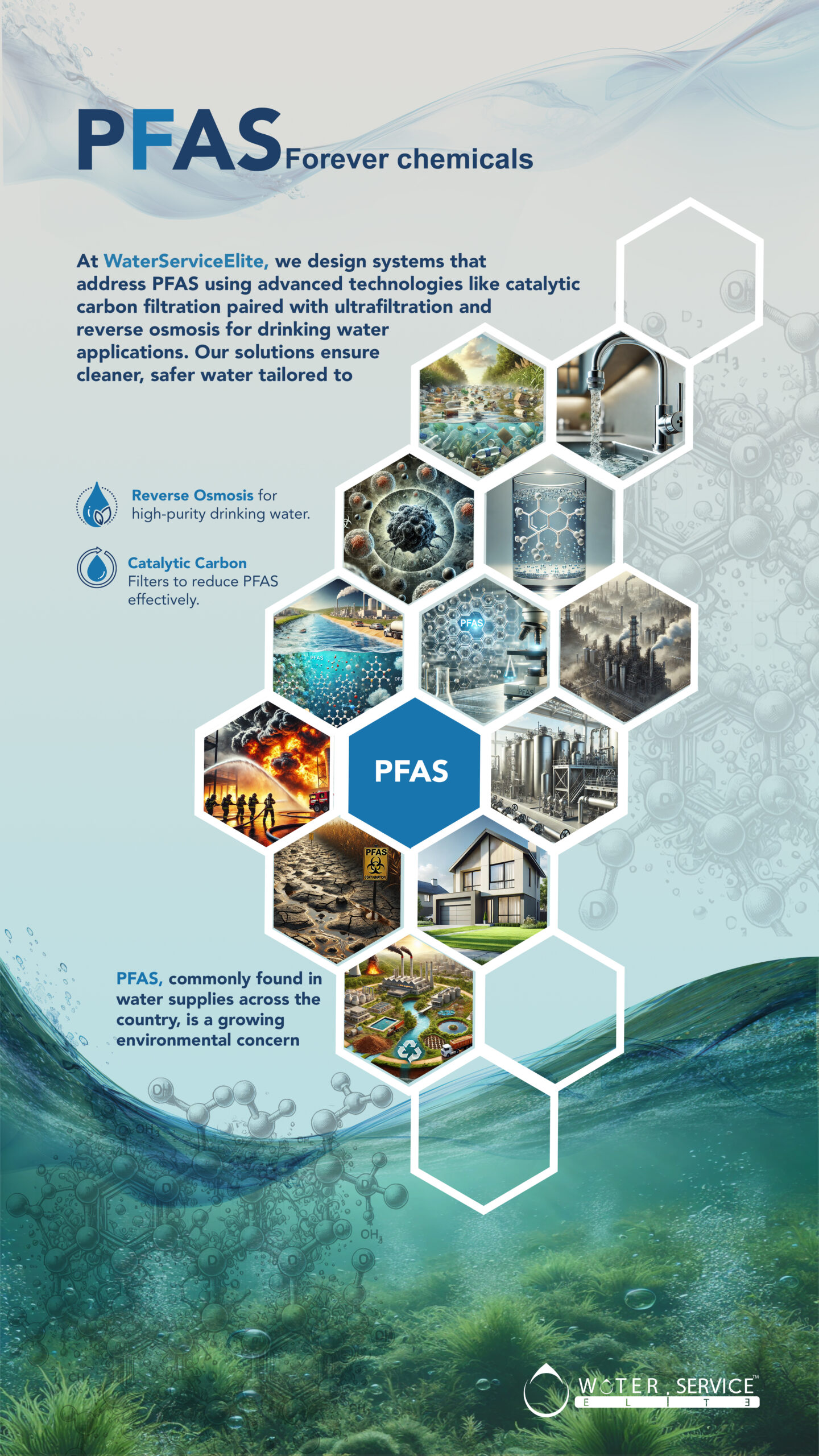
- February 05, 2025
What Are PFAS?
PFAS, or per- and polyfluoroalkyl substances, are often referred to as “forever chemicals” due to their persistence in the environment. These man-made chemicals are commonly found in water supplies across the country and have become a growing environmental and health concern. PFAS are used in a wide range of products, including firefighting foam, non-stick cookware, food packaging, and industrial processes. Their widespread use and resistance to degradation make them a significant challenge in water treatment.
The Risks of PFAS in Water Supplies
PFAS contamination in water is linked to numerous health issues, including developmental problems in children, weakened immune response, and increased risks of heath issues. Because these substances do not break down easily, they can accumulate in water systems over time, affecting communities and ecosystems.
Our Advanced PFAS Solutions
At WaterServiceElite, we are committed to addressing the challenges posed by PFAS contamination. Our systems use advanced technologies to provide cleaner, safer water for households, businesses, and industries. These solutions are tailored to meet the highest standards of water purity:
- Reverse Osmosis Systems: These systems are highly effective at removing PFAS, delivering high-purity drinking water for your home or business.
- Catalytic Carbon Filters: Designed to target and reduce PFAS efficiently, these filters are a vital part of our multi-layered treatment systems.
Tailored to Your Needs
Our team works with clients to design customized solutions that effectively reduce PFAS in their water supplies. Whether you’re managing a municipal water system, operating an industrial facility, or safeguarding your family’s health, we provide a solution to fit your needs.
- February 05, 2025
Why Choose WaterServiceElite?
With expertise in water treatment and a commitment to innovation, WaterServiceElite delivers solutions that not only meet regulatory standards but also go above and beyond to provide peace of mind. Our advanced technologies ensure effective removal of PFAS while being efficient, reliable, and environmentally friendly.
Act Now to Address PFAS
PFAS contamination is a growing issue, but you don’t have to face it alone. WaterServiceElite is here to help protect your water supply, your health, and the environment. Contact us today to learn more about our cutting-edge PFAS treatment systems and how we can customize a solution to meet your specific needs.
Together, we can tackle the challenges of PFAS contamination and ensure a safer, healthier future.
Read more  WQA PFAS Portal
WQA PFAS Portal
🔗 PFAS Consumer Guide (PDF)
WQA Update: What Water Treatment Professionals need to know about Wildfires
- January 15, 2025
This document from the Water Quality Association (WQA) provides guidance for water treatment professionals on how wildfires impact water quality and how to respond to these challenges. Key points include:
1. Impacts of Wildfires on Water Quality:
- Ash and Runoff Contamination: Wildfires can change water quality in lakes and streams by increasing alkalinity, pH, and organic content, which raises chlorine demand and increases disinfection byproducts.
- VOC Contamination: Damaged pipes during wildfires can introduce soot, ash, and volatile organic compounds (VOCs) into the water supply. Post-wildfire VOC levels can reach hazardous concentrations, e.g., benzene up to 40,000 µg/L.
- Thermal Pipe Degradation: Heat from fires can degrade plastic pipes, causing harmful chemicals to leach into the water.
2. Health Risks:
- Elevated VOC levels in water can cause severe health issues such as cancer, organ damage, and respiratory problems, especially in children.
3. Recommendations for Water Professionals:
- Testing for VOCs: Essential before implementing treatment. Some water with high VOC levels may be untreatable, necessitating bottled water.
- Sanitizing Equipment: Replace or sanitize water treatment systems as needed.
- Boil Water Alerts: Use bottled water during alerts, as boiling may not address VOC contamination and could increase inhalation risks.
4. Resources for Testing and Response:
- Certified drinking water laboratories can test for VOCs. Instructions for sampling are provided by the lab.
- WQA and EPA offer detailed resources and guidance for addressing wildfire-related water contamination.
The document underscores the importance of vigilance and informed responses by water treatment professionals in post-wildfire scenarios to ensure water safety and quality.
Read the full document here: handout
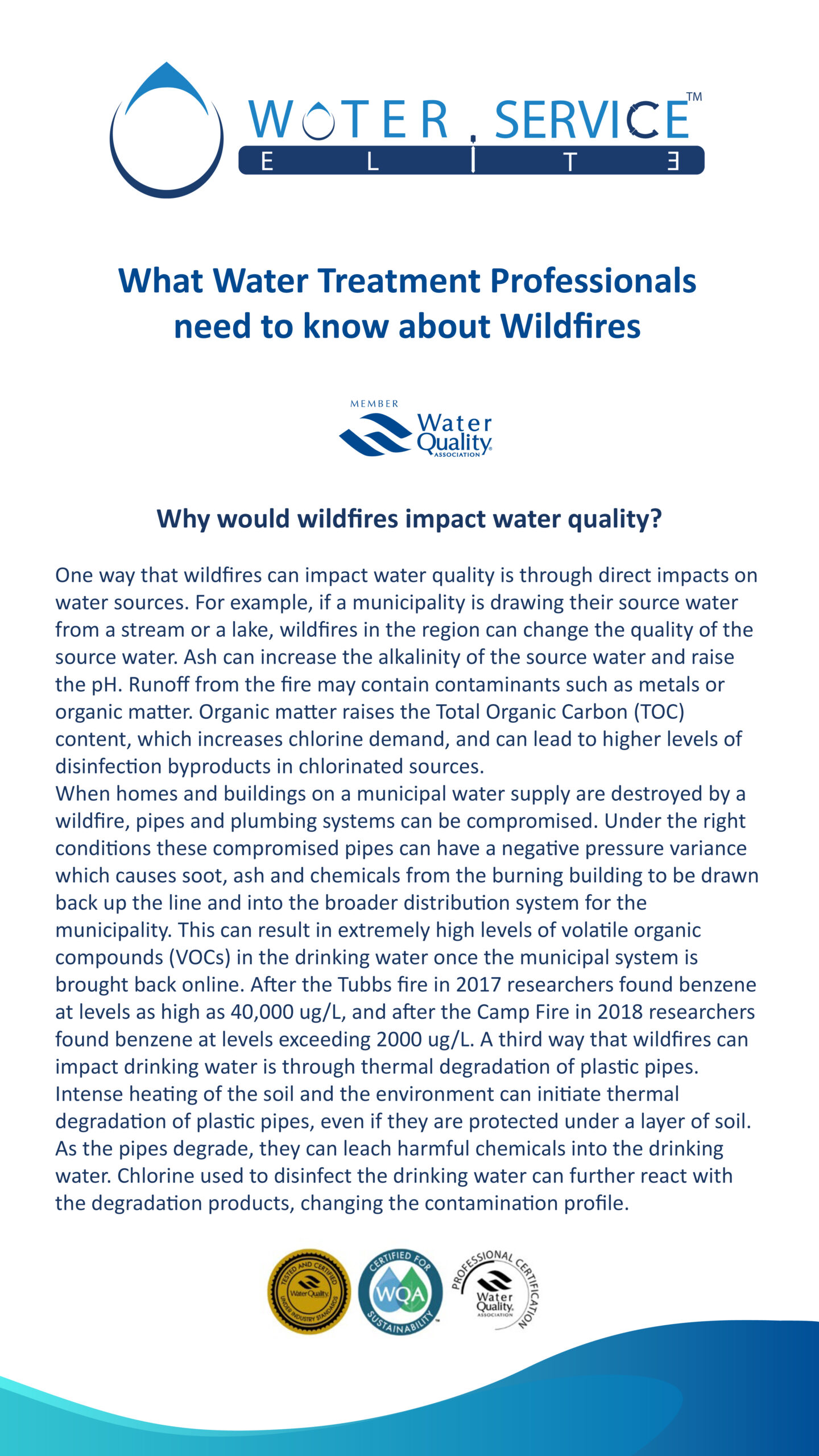
Advanced Legionella Mitigation Solutions by Canopus Water Technologies
Discover How Our Business Partner Canopus Water Technologies is Transforming Health Care Infection Control on WC&P Online
- January 01, 2025
Water safety is a top priority in health care, with a focus on eliminating health care-associated infections (HAIs). Our esteemed business partner, Canopus Water Technologies, has showcased cutting-edge solutions for Legionella mitigation in their recent article on WC&P Online.
Understanding the Legionella Challenge
Legionella pneumophila, the bacterium causing Legionnaires’ disease, thrives in stagnant, warm water systems often found in health care facilities. This poses significant risks, particularly in complex water systems like those in hospitals and long-term care facilities.
Canopus’ Advanced Solutions
Our business partner, Canopus Water Technologies, offers innovative UVC LED systems that represent the forefront of water disinfection. Key benefits of their systems include:
- A 6-log reduction (99.9999%) of Legionella bacteria.
- Mercury-free, energy-efficient designs with instant on-off functionality.
- Rugged, compact systems that operate reliably in challenging health care environments.
Sustainability at the Core
In addition to unparalleled disinfection, Canopus UVC LED systems align with sustainability goals. Their eco-friendly, durable, and low-maintenance designs ensure compliance with stringent CDC guidelines while supporting long-term operational efficiency.
A Partnership for Health and Safety
Collaborating with Canopus Water Technologies enables health care facilities to achieve enhanced water safety, significantly reducing the risks posed by Legionella. These advanced solutions represent a proactive step toward protecting lives, minimizing infections, and achieving sustainability targets.
Read the full article on WC&P Online here: Legionella Mitigation in Health Care Facilities
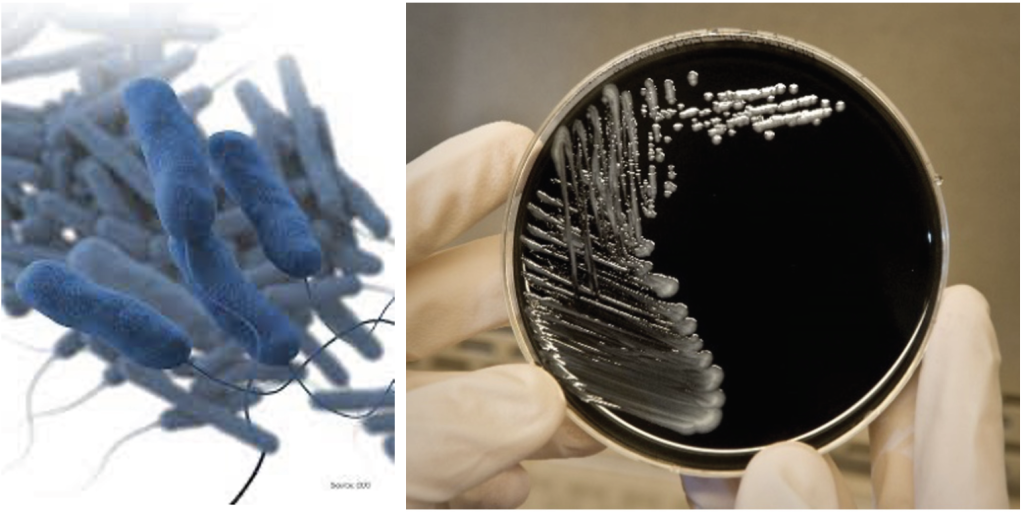
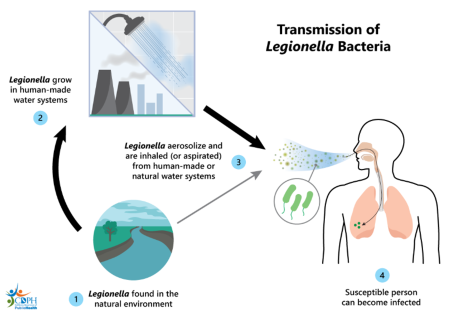

Sustainable Water Solutions for Homes with Water Service Elite
In our latest podcast, we dive deep into the world of water filtration, exploring its critical role in ensuring clean, safe, and great-tasting water for households and businesses alike. Our Sales Manager and Technical Engineer sit down with Bradley Leavitt, a seasoned expert in the field, to discuss the many benefits of advanced filtration systems and why investing in clean water is more important than ever.
- October 10, 2024
Key Topics Covered:
- The Science Behind Water Filtration: Understanding how modern filtration systems like ultra-filtration and reverse osmosis remove contaminants and improve water quality.
- Why Water Quality Matters: Bradley Leavitt shares insights on how water quality impacts daily life, from drinking water safety to the overall well-being of communities.
- Choosing the Right Filtration System: Our team discusses different types of systems, including point-of-entry and point-of-use options, helping you make an informed choice for your needs.
- Sustainability and Efficiency: Learn how our latest water filtration technologies are designed to save water and reduce environmental impact, all while delivering crystal-clear results.
Tune in to the full podcast to gain a deeper understanding of how filtration systems work, and why they’re an essential part of maintaining a healthy lifestyle. Whether you’re a homeowner looking to improve your water quality or a business seeking reliable water solutions, this episode is packed with valuable information and expert advice.
Key Outcomes from Our Latest Estate Manager Meeting
In our ongoing effort to enhance the living standards within our estates, the focus of our latest estate manager meeting was on the critical role of water filtration systems. This meeting addressed current challenges, explored new advancements, and set forth plans to ensure the highest quality of water for our residents.
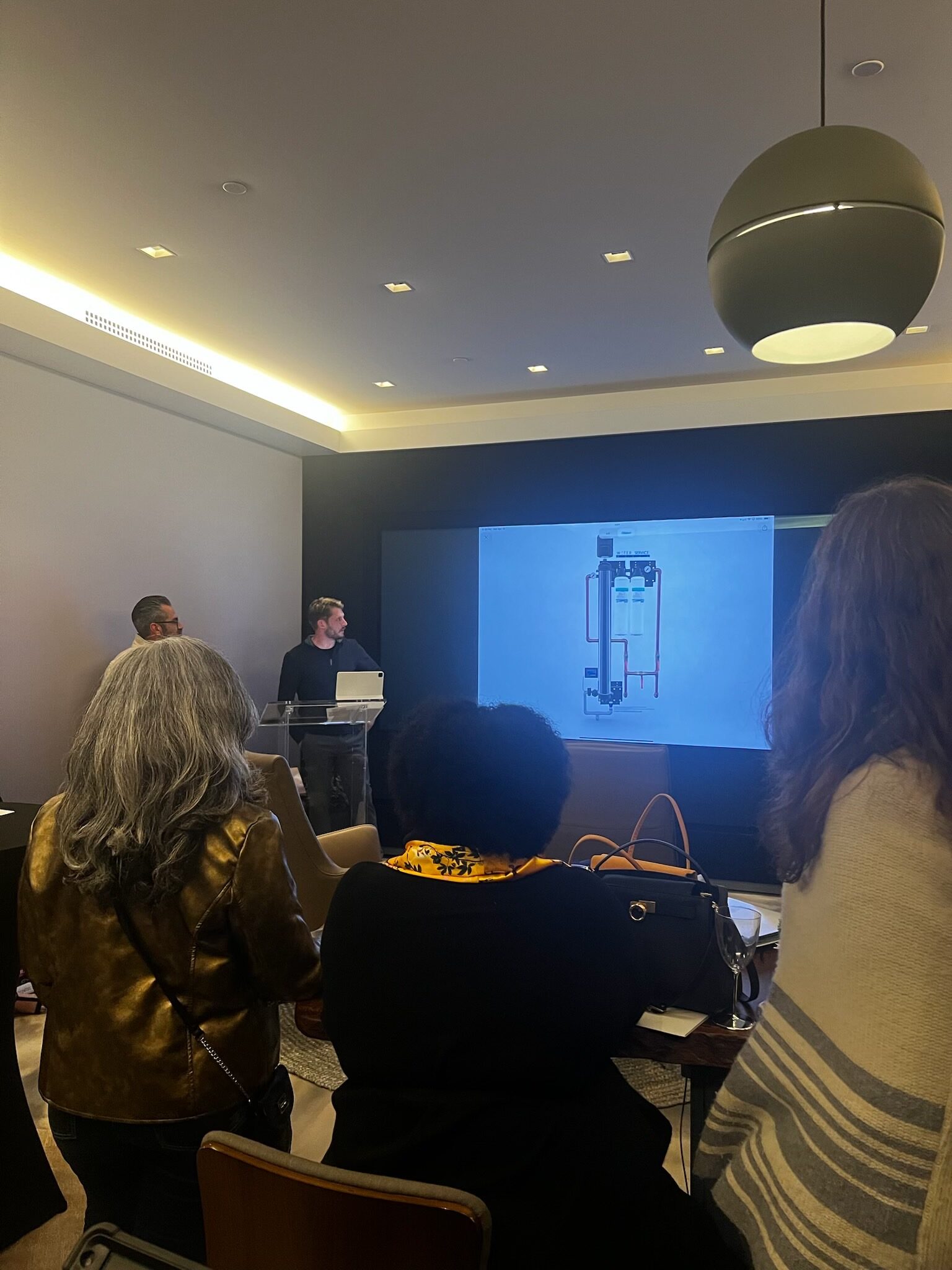
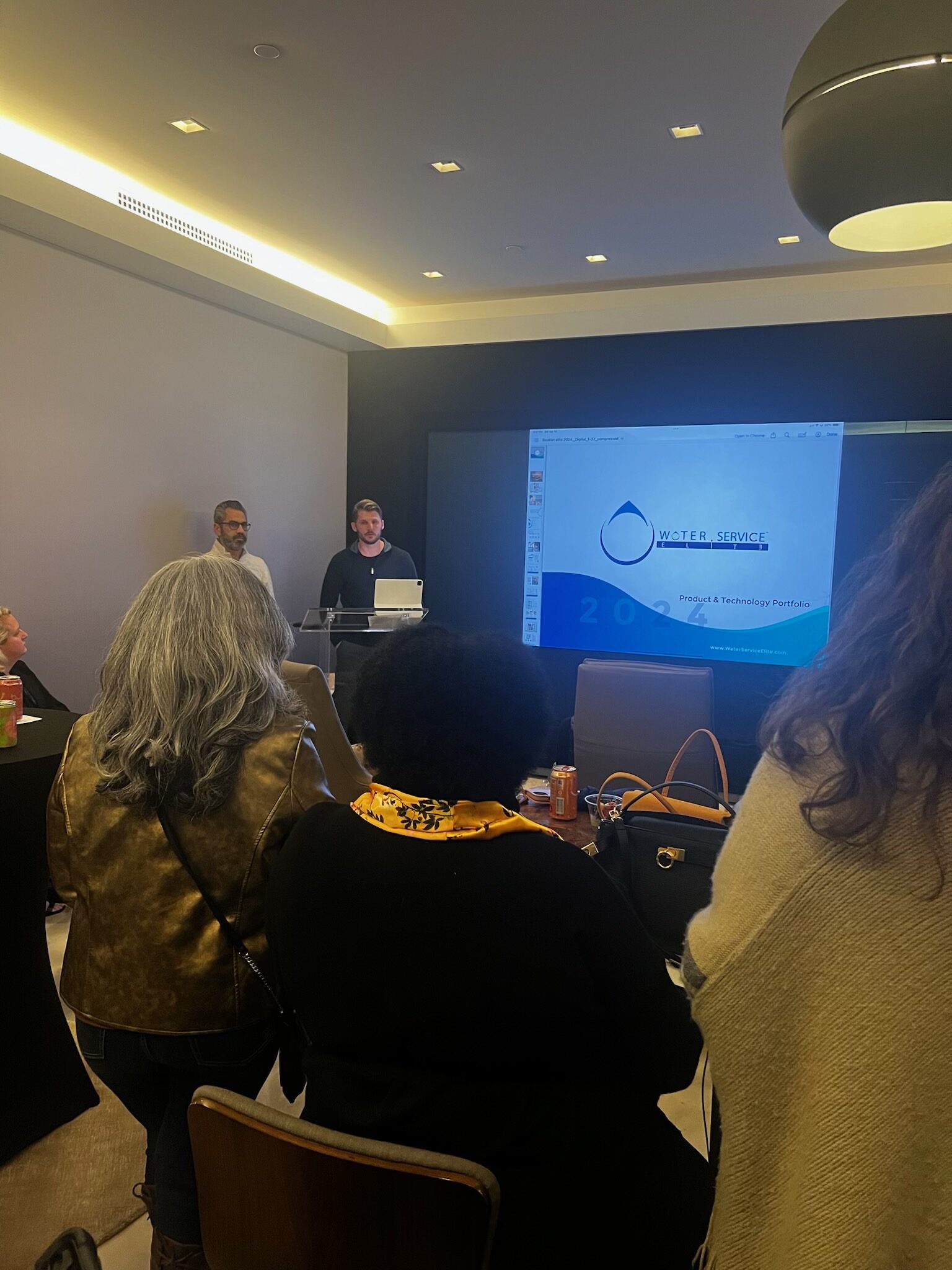
- February 25, 2024
Meeting Overview: Held on February 25, 2024, the meeting brought together estate managers from across our portfolio to discuss the integration, maintenance, and future enhancements of water filtration systems in our properties.
Key Discussions:
Review of Current Filtration Systems:
- Assessment of the performance and reliability of existing systems.
- Feedback from residents about water quality and system usability.
Advancements in Filtration Technology:
- Presentation of newer, more efficient technologies in water filtration.
- Consideration of upgrades to more eco-friendly and cost-effective systems.
Implementation Strategies:
- Plans for the rollout of new systems in estates lacking advanced filtration.
- Timeline and budget allocation for upcoming upgrades.
Maintenance Protocols:
- Standardizing maintenance schedules across all properties.
- Training for onsite staff to handle routine checks and minor repairs.
Regulatory Compliance and Sustainability:
- Update on local water quality regulations and compliance requirements.
- Discussion on sustainable practices in water management and conservation.
Highlights from the Meeting:
- Interactive Session: A hands-on demonstration by a water filtration expert showcasing the latest filter technology.
- Case Studies: Reviews of before and after scenarios post-installation of advanced systems in select properties.
Decisions Made:
- Upgrade Plan: Approval of a phased upgrade plan for older systems.
- Budget Approval: Greenlighting the proposed budget for the next fiscal year focusing on water filtration improvements.
Conclusion: The latest estate manager meeting marks a significant step towards ensuring that our properties are equipped with the best in water filtration technology. Our commitment to providing safe, clean, and reliable water reflects our dedication to the well-being of all residents.
Stay tuned for updates on our progress and more insights from future meetings.
A Reservoir of Knowledge
Dive deep into the realm of water treatment with Water Service Elite's Insights. Here, we merge expertise with passion, offering a treasure trove of articles, updates, and tips about the ever-evolving world of water purification.
From understanding the intricacies of reverse osmosis to decoding the latest advancements in ozone treatments, our blog promises clarity, knowledge, and a peek into what drives us—ensuring that every drop of water is a story of purity
- October 16, 2024

